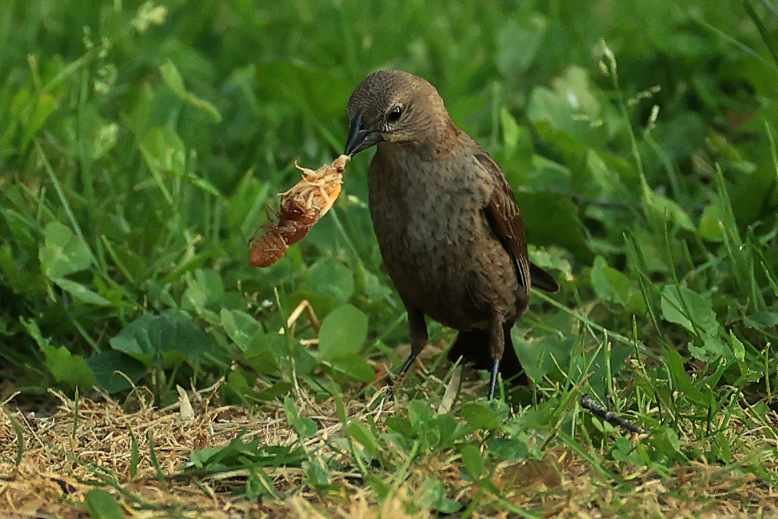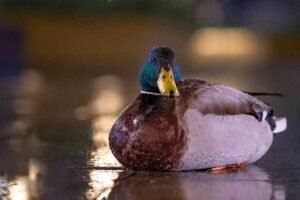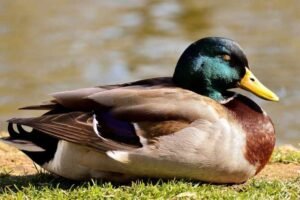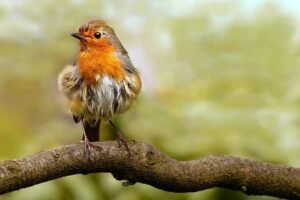Cicadas are noisy insects that can be heard and found in abundance during the scorching months of summer. Their loud buzzing sound makes them kind of annoying, but luckily there are a lot of bird species such as woodpeckers, thrushes, owls, ravens, warblers, and jays that love to feast on these insects. Songbirds such as sparrows and Robbins like to munch on nymphs with great delight, while predator birds consume both adult cicadas and nymphs.
These bugs contain a large number of amino acids and proteins, making them a great diet for our avian friends. In fact, a lot of bird species specially migrate to places where there is an abundance of these noisy insects to take advantage of the rich diet available for a short period only. It is interesting to know that cicadas aren’t a year-round meal. They only appear during the summer and once every 17 years for their periodical species. Aside from birds, raccoons and some other pets also like to eat cicadas.

Birds that love cicadas
Almost all bird species love to feed on insects and cicadas are no exception! When these bugs crawl into the world as nymphs, they come into a swamp of billions. Their mass existence makes it effortless for predator Birds to feast on them. But what birds feast on cicadas?
Let’s explore 18 birds species that love eating cicadas
- Woodpecker
Gifted with a robust beak to hunt and peck seamlessly, woodpeckers are always foraging for food. They like to eat SAP tree bark and insects during the summer and spring. Nonetheless, during the fall, they switch to cicadas. There are around 15 species of woodpeckers that love to eat these insects. Woodpeckers normally prefer adult ones over larvae and nymphs. But of course, these bugs mature in a matter of a few days. So what woodpeckers don’t eat in the initial period of emergence, could be their meal in the next few days.
- Wrens
Wren, a small and adorable songbird native to North America, loves to enjoy cicadas. These bugs are quite prevalent in the summer season so it isn’t uncommon for this bird to make them a part of their diet. Wrens often build their nest in a place where there are plenty of cicadas around. It gives them an ideal opportunity to find enough food nearby. These bugs make an important part of the wren’s diet and they happily consume around 20 to 40 cicadas per day!
- Blue jays
Blue Jays are large-bodied birds with a friendly public image. But don’t get tricked by their appearance as these guys are proficient hunters and eat a lot of insects. Plus, they are quite territorial.
Some bird admirers believe that blue jays usually migrate when the cicada brood comes in full force. But others have reported a surge in their number in the time after the brood. It could be possible that the buzzing noise of these insects pushes them away for some time but they still love eating a ton of cicadas.
An interesting fact about blue jays is that they are not likely to hunt these bugs down as there are a lot of food options they can find with ease. If these insects happen to fly into the trees where these birds nest, they will devour them. Blue jays are fond of easy meals with no effort required on their part.
- Common House Sparrow
By now we have been talking about expert Predator Birds that feast on cicadas. But do you know that Common House sparrows also love to munch on cicadas as well?
Well, it is absolutely true. This small bird loves cleaning your backyard and neighbourhood of annoying insects. House sparrows are opportunistic feeders, and they will surely consume cicadas in hot weather when they are plentiful. They also seem to enjoy other things like berries seeds grains nuts and some vegetation.
- Cuckoos
According to Avian observers and scientists, Cuckoos are amongst the few Birds species that intentionally migrate to take advantage of the great cicada boom.
Most Birds species don’t bother travelling to gulp these defenceless and colourful insects, but cuckoos are an exception. This illustrates just how much they love eating them.
The cuckoo migration isn’t only limited to the 17-year brood. They usually travel around the country to take advantage of the cicada outbreak, using them as a delicious and nutritious food source.
- Thrushes
Thrushes are small to medium-sized birds that absolutely love to feast on cicadas. They are expert Hunters and can catch insects flying in the air or crawling on the ground with little effort. Their exceptional hunting capabilities make cicadas an ideal target for them as these birds can get to wherever the insects are.
- Crows
Crows are notorious for their scavenging capabilities. They always seem to be there where the food is, gulping down everything they can get their strong beaks and powerful claws on.
However, not many people know that crows also feed on cicadas. They gather in groups to feast on these noisy insects. While crows eat cicadas, people nearby can hear their distinct bird calls.
Crows usually eat only the soft part of the bug and discard the hard shell and wings. They peck at the head and suck all the fluid present inside. A crow’s capability to consume these insects makes this bird a critical member of our ecosystem where it can help control insect infestations.
- Common grackle
Every year in autumn, grackles visit the areas with cicadas infestation. They keep on gulping these bugs down for weeks before returning to their original nests. Grackles are notorious for swooping down from trees with mouths wide open for food. The reason behind their love for bugs could be the fact that insect bodies are in rich with fats and proteins that can help them cope with harsh weather conditions without adequate food sources.
- Buntings
Buntings are widespread across the United States. Their different kinds including varied bunting painted bunting and blue bunting consumes most insects, but their preferred delicacy is cicadas. Buntings look for these bugs on trees and use their strong beaks to tear them apart. These birds are likely to eat anything they can get their claws, on but when there aren’t many food options available, they may spend their days eating worms and spiders.
- Shrikes
Cicadas are a favourite treat for many shrike species. Northern Shrike and common shrike loggerhead shrike all have an appetite for these bugs.
Shrikes use their strong and hooked bills to catch their prey by jabbing it into the tree bark. These birds can devour up to fifty or more cicadas in a single day!
- Common starling
Starling isn’t picky eaters and will eat a wide variety of food items. This includes both animal matter and plant-based foods such as fruits insects and seeds. Birdwatchers have often seen them feeding on amphibians and small mammals.
When cicadas emerge from the ground to mate and lay eggs on trees and bushes before dying off in winter, these medium-sized colourful fowls nest in the trees containing these insects to feed on them.
- Herons
These majestic birds are commonly found in different areas of the east coast. They are style hunters and can take down their prey whether it is large or small.
Cicadas make a lovely snack for these graceful birds. Herons love to gulp adult cicadas down but will eat younger ones as well.
- Falcons
You must be surprised why this majestic bird of prey is on this list, but an overwhelming cicada’s brood is an opportunity too good to pass even for a falcon. Cicadas offer all the calories and nutrition any bird would need. So falcons don’t seem to mind enjoying cicadas to their full. Their excellent speed makes hunting cicadas an effortless experience for them.
- Hawks
As a bird of prey, hawks hunt for meals with a smoothness that amazes birdwatchers. They enjoy eating smaller birds but insects are a healthy part of their diet too.
Thanks to their fast diving skills, catching cicadas is a no-brainer for them.
- Seagulls
Seagulls have a huge appetite and will eat pretty much anything. However, their love for eating cicadas isn’t hidden from any avian watcher.
These sea chickens have to eat a lot to maintain their size. Thereby when the cicadas brood comes along, they are happy gorgers.
- Cardinals
If you have these splendidly colourful birds residing near you, you will love watching them hop around on trees and bushes foraging for food.
These bright-coloured birds are also known to consume cicadas. Perhaps they like taking advantage of the huge number of insects during the cicadas outbreak.
- Mallards
Mallards or wild ducks have been seen consuming cicadas to their full. These waterfowls love to eat bugs of all shapes and sizes, and if they get an opportunity to grab an unlucky bug that falls into the water, they will happily chew it up.
- Tufted titmouse
The tufted titmouse rounds out our list of birds that love feasting on cicadas. They love to grab a cicada and can consume up to 50 cicadas in only a day. This may be due to their opportunistic feeding habits and adaptation to food availability.
Final words.
Cicadas are periodic insects made up of 50% essential nutrients and protein. They have a short lifespan but make a healthy snack for most bird species.




